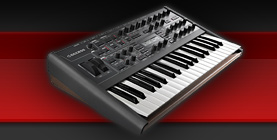

|
|||||||
| Sound designing Discussion about sound designing with the Virus series synths. Share patches and your knowledge or ask questions. |
 |
|
|
Thread Tools | Search this Thread | Display Modes |
|
#41
|
||||
|
||||
|
Quote:
The first bit is always the hardest and the most frustrating. Stick with it and you'll never look back. Best wishes m8 Timo |
|
#42
|
||||
|
||||
|
I think the sample is good, i dont think you should stray from it...but you should learn more about theory...what notes were you using? and ill figure out the chords for you...
peace Blank Edit if you were hitting C with that tuning it would be, i believe, a Sus2 chord
__________________
"Hopefully one day i will be known as a synth programmer" |
|
#43
|
|||
|
|||
|
hiya blank..
well.. all sharps.. f#, g#, c# and d# so the first note would be an f# and a b and e an octave up? |
|
#44
|
||||
|
||||
|
0 +7 +14
F#C#G# G#D#A# C#G#D# D#A#F These are all Sus2 chords...These chords are when you take out the 3rd of a chord ie C-E-G (1-3-5) and replace it with a 2nd (D) "C scale C-D-E-F-G-A-B or 1-2-3-4-5-6-7" now yours are not arranged the standard way but still use the same notes...the only other thing it could be is a 5add9 which Im not sure if it exists...but I would stick with the Sus2...Anyway this is why it has a major feel, because these chords dont need to resolve to another chord...But this doesnt mean that they are major chords, they just sound major... peace Blank
__________________
"Hopefully one day i will be known as a synth programmer" |
|
#45
|
||||
|
||||
|
Quote:
Quote:
__________________
Check out my new sounds. Electrodub and psychedelia for people! |
|
#46
|
||||
|
||||
|
well there is no real difference, the only reason i said that is that if you have the true F#Sus2 it would be F#G#C# what he has is F#C#G#(+1 oct) and you can do both inversions of F#G#C# and never really get the true Sus2 (notationally)...but if you think about it, you can invert a 9th and it becomes a 2nd so then you would get the F#G#C#...but if you look at if for face value the way its played it is really a 5add9 which doesnt exist...atleast i cant find one...kind of an enharmonic spelling...
As for the second part Sus2's do not need to be resolved...Sus/Sus4's do because the have an upward motion; 4th is only a half step above the 3rd giving it that upward motion...but the Sus2 is a whole step below the 3rd giving it more disconnection from the chord progression peace Blank
__________________
"Hopefully one day i will be known as a synth programmer" |
|
#47
|
|||
|
|||
|
There is a definite difference between a sus2 chord and a 5add9 chord. A sus2 chord implies scale degrees 1,2, and 5 (in the key of C these would be the notes C,D, and G). However, a 5add9 chord implies scale degrees 1,3,5,9 (in C these would be C,E,G,D); a C5add9 could also be interpreted as a C9 chord without the seventh (Bb in this situation). The actual voicing of the chords depends on the musical situation. Thus, a Csus2 chord could actually have a distance of a major ninth (M9) between the C and D while the C5add9 chord could actually have a distance of a major second (M2) between the C and D.
It is true that the 2nd and 9th are the same scale degree of a chord (in C, they are both D). This is also true for the 11th (F in the key of C, which is also the 4th) and the 13th (A in the key of C, which is also the 6th) These additional notes beyond the basic 7th chord are called extensions, and chords that employ them are called extended chords. There is a convention that is often but not always followed when notating extended chords. When dealing with extended chords with a major function (like a major 7 chord, a major 6/9 chord, a major sus chord, etc.), the extentions are typically notated with the smaller number, i.e. 2,4,6. When dealing with extended chords with a dominant function (like C7, C9, C7#11, etc.) the larger numbers are used to denote the extensions, i.e. 9, 11, 13. This makes it easier to sight-read chord changes and improvise successful voicings. Sorry if this post is lengthy but I hope it's helpful! Also, it's important to remember that theory is good but the only things that really matter are what you can hear and what you create. |
|
#48
|
||||
|
||||
|
I truely do not see the difference here, besides the just making it easier to read/write...Notes can be omitted from chords and still be that chord... its the intervals that matter and when you have a 2nd and and 11th, they are for the most part interchangeable...The only difference i see like i said b4 is the note sequence...other then that it uses the same notes just written in a grouping...Unless im wrong?
peace Blank
__________________
"Hopefully one day i will be known as a synth programmer" |
|
#49
|
|||
|
|||
|
What you're saying about the importance of interval relationships in the definition of chords is accurate in traditional "school" functional harmony, but the chord theory that applies to contempory music is quite different. Intervallic relationships cease to be as important as modal functions and "color". Take an extended minor chord, for example Dmin11. There are a number of ways to voice this chord function using different types of intervallic relationships and therefore bringing out different colors of the function. We could voice it with all fourths: D,G,C,F. We can voice it with a combination of fourths and thirds: D,G,C,F,A. We can voice it with all thirds: D,F,A,C. We can voice it with seconds and fourths: C,D,F,G. All of these voicings sound very different, yet could be interpreted as Dmin11.
The important thing to remember about the harmonic structures that appear in much electronic dance music (and Rock and Roll,RnB, modal-jazz, etc.) is that they are most related to the harmonic concepts of modalism (Debussy and Ravel started these theoretical ideas in the Concert Music tradition and players like Miles Davis, Billy Strayhorn, and John Coltrane in the Jazz tradition). Without a ridiculous digression, suffice it to say that your typical college theory textbook (which is teaching "Functional Harmony") is leaving out the picture of the harmonic basis of most contemporary music. In Mozart's time (which is what these basic theory texts explain) every chord had a very clear function and existed in a very obvious harmonic scheme. Such is often not the case today, where chords/modes are much more likened to the concept in the visual arts of complementary and uncomplementary colors. I don't mean to digress with lengthy explanations, but I often feel with my students and with my own studies than an understanding of modal harmony as an aspect of the Ambient ethos often goes hand in hand with creating high quality electronic music. |
|
#50
|
||||
|
||||
|
I dont know about you but my theory professor had a quite adaptive method of teaching...
Im not going to get into this anymore until you answer a few questions for me...because to me it sounds like you are saying the same thing with new labels...what is your definition of modal functions? whats your definition of color? Intervallic relationships cease to be as important as modal functions and "color" There are a number of ways to voice this chord function using different types of intervallic relationships "and therefore" bringing out different colors of the function Sounds like to me intervals still seem pretty important... unless you are saying that you could not analyze these dm11 chords with "traditional theory"? Do you use the roman numeral system or is it the guitar theory system (G7b5 Cm11), atleast thats what i call it(not quite sure the name i just know a ton of guitarists that use this system)? Hell from what my professor taught me modal harmony was included in the whole of music theory, there was no seperation from "traditional" or "modern" theory...It sounds like you are talking about contemporary classical style which began to implement chromaticism more into music and started to throw away the diatonic or "traditional" forms using chord pivoting/chord morphing/chromatic chords and such things of that nature..?I honestly dont see the seperation here...if you care to elaborate i wouldnt mind listening but i only ask this do not stereotype my knowledge and do not try to "school" me...because if there is a difference i would really like to know, but i honestly think that its more of a misunderstanding of definitions... peace Blank
__________________
"Hopefully one day i will be known as a synth programmer" |
 |
«
Previous Thread
|
Next Thread
»
| Thread Tools | Search this Thread |
| Display Modes | |
|
|
 Similar Threads
Similar Threads
|
||||
| Thread | Thread Starter | Forum | Replies | Last Post |
| Wavetable PWM oscillator on the TI OS v2 | Timo | General discussion about Access Virus | 3 | 12.12.2007 08:34 AM |
| VA oscillator differences | r3dnaX | Sound designing | 24 | 17.08.2004 08:41 PM |
| Oscillator 3 | Szathy | General discussion about Access Virus | 1 | 17.03.2004 12:08 PM |
All times are GMT. The time now is 08:51 PM.
Powered by vBulletin® Version 3.6.4
Copyright ©2000 - 2024, Jelsoft Enterprises Ltd.
Skin Designed by: Talk vBulletin
Copyright ©2000 - 2024, Jelsoft Enterprises Ltd.
Skin Designed by: Talk vBulletin
Copyright ©2002-2022, Infekted.org
 |
 |








 Linear Mode
Linear Mode

